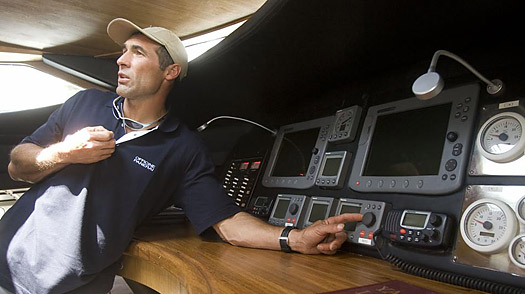
South African adventurer Mike Horn.
For South African-born explorer Mike Horn, 42, navigating in sub-zero temperatures requires basic tools: chocolate for energy and mucus for wind-block. It also helps to have a few complex tools, such as a custom-built watch. Horn has circumnavigated the Arctic Circle solo, circled the globe along the equator without motorized transport and completed the first-ever night expedition to the North Pole, without dogs and frequently swimming along the way. So it makes sense that the Italian watchmaker Officine Panerai, known for their supersized dials and tough-as-nails construction, would find Horn to be the ideal partner to test new models. After all the brand has been involved in nautical adventure since making watches for the Italian Navy in the 1930s.
Back in 2002, Panerai helped foot the bill on Horn's expedition around the Arctic Circle and, in return, Horn put their Luminor Arktos through its paces skiing, sailing, kayaking and trekking in temperatures as low as -76 F (-60 C). When everything else on him was frozen, his watch, remarkably, still worked. This year, as Horn embarks on his most ambitious expedition to date — Pangaea — he's taking Panerai back to its seafaring roots. Not only is Horn wearing a specially designed model, the Luminor 1950 Submersible Depth Gauge, on his journey, he's also employing the brand's expertise to outfit his ship with a hygrometer, thermometer and barometer.
Pangaea is named after the supercontinent that once dominated the planet and is an acronym for Pan Global Adventure for Environmental Action. Unlike Horn's earlier expeditions, which were primarily personal challenges, his goal for Pangaea is to share his knowledge and raise awareness of the perilous state of the planet. Over four years the Pangaea expedition will visit all seven continents and navigate the world's oceans. The headquarters for the expedition is a custom-designed 115-ft. (35-m.) sailboat of the same name, fitted with the latest technologies and constructed with the goal of being as sustainable as constraints allow. Recyclable aluminum was chosen as the hull material, LED bulbs light the ship and trawling nets collect stray bottles floating at sea. Solar panels work in conjunction with an electrolyser, hydrogen storage and fuel cell system to provide electricity. All of which means the boat's footprint is as small as possible.
The scope of Horn's adventure is expanded by his admission of educational specialists and specially selected students (ages 13-20) to join his expedition as part of a Young Explorers Programme. Over the course of the trip, 12 groups will meet up with Pangaea for 10-12 days at a time, learning, experiencing and, ultimately, disseminating their new knowledge to the various corners of the Earth from which they hail. Already Pangaea has successfully hosted one of these groups.
Since the expedition's official start on October 18, Horn and his crew have negotiated the waters of Antarctica and introduced the first group of Young Explorers to icy islands and colonies of penguins, whilst conducting research on the ice and snow. Since the departure of the Young Explorers, Horn has also temporarily left the ship and begun his trek to the South Pole. He calls in to his team frequently and reports are updated daily on his website (mikehorn.com). Progress is slow and arduous. Horn spends his days hauling his supplies on a sled over tricky terrain and fighting temperatures that are -13 F (-25 C) and dropping. For the average person it's a nightmare, but for Horn it's just the beginning and for Officine Panerai it's the ultimate test of quality.